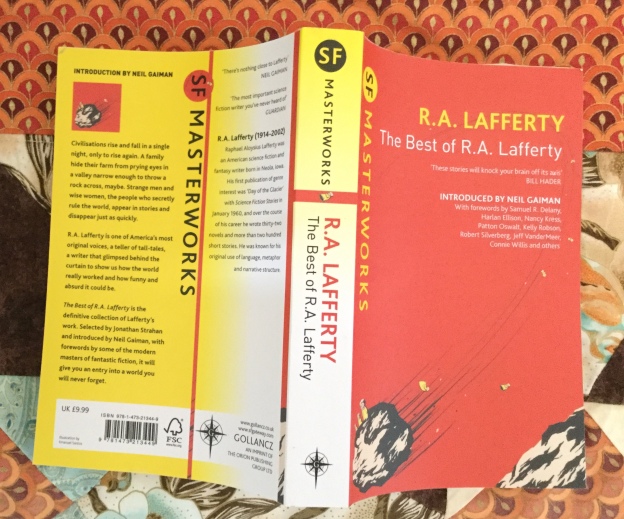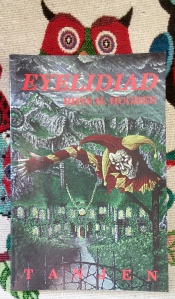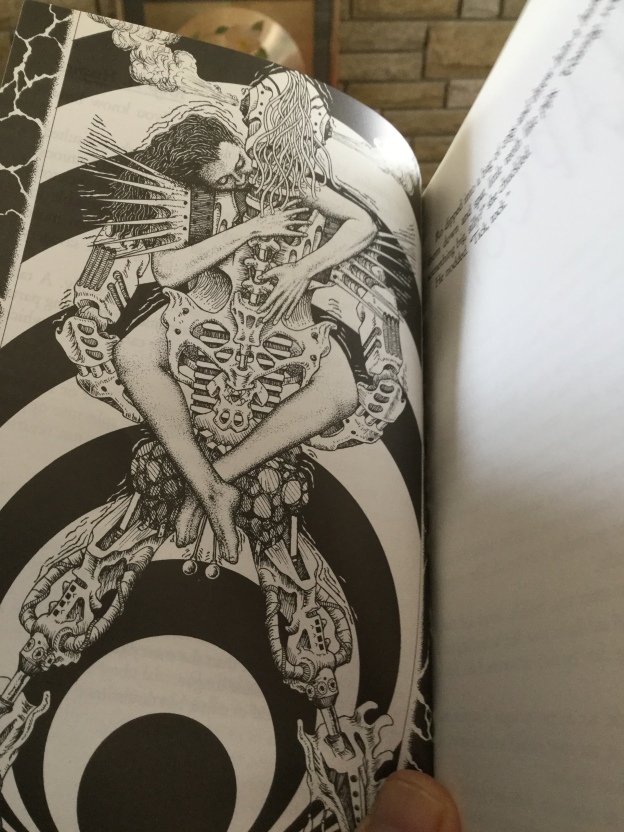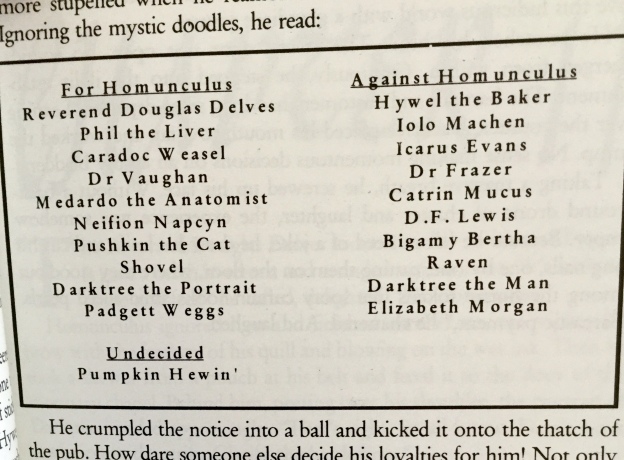The Best of R.A. Lafferty

GOLLANCZ 2019
Edited by Jonathan Strahan
Stories by R.A. Lafferty, with introductions by Neil Gaiman, Michael Dirda, Michael Swanwick, Michael Bishop, Terry Bisson, Jack Dann, Patton Oswalt, Andy Duncan, Harlan Ellison, Gregory Frost, Robert Silverberg, Kelley Robson, Samuel R. Delany, Nancy Kress, Gwenda Bond, Gregory Feeley, Connie Willis, Cat Rambo, John Scalzi, Andrew Ferguson, Jeff VanderMeer, Gary K. Wolfe.
When I read this book, my thoughts will appear in the comment stream below…








“, ‘and I paid you back tenfold by messenger before midnight.’”
This 1965 work, a cross between Rhys Hughes fictionatronics and Finnegans Wake (literary favourites of mine) seems to approximate a prophecy of fast communication and exchange with ‘modules’ as apps. With all the fallibilities that the Internet today magnifies in humanity; it even hints at Brexit (collapsing empires and recombining their wreckage) and Trump (the reigning President of the Toppers’ club, was enjoying himself with his cronies).
“So he burns leaves and bark and made a speech:
‘That my valley be always wide and flourish and green and such stuff as that!’ he orated in Pawnee chant style. ‘But that it be narrow if an intruder come.’”
Perfect! Not only in itself (more later) but in its inadvertent but powerful mutual-synergy with ‘Creation Story’ that I preternaturally read/reviewed only a few hours ago in a simultaneous real-time review here. Narrow Valley in itself is a wonderful story of this Old Indian’s land fending off the Rampart family’s claim on the land (a family with delightfully precocious children) and the scientific explanations of the visual effects of narrowing and widening involved, whether seismic or not. “Nothing wenchered, nothing gained,” being one wise saw, and “looming only in reverse,” a ‘group illusion’ like this real-time gestalt, “I want my land. I want my children! I want my wife.” And “the case of Mad Mountain” like HPL’s Mountains of Madness? “Chahiksi!” Perfect!
‘“‘Whales in the sky’ is the code-name for this study,…”
A Swiftian / Fortean story of story-setting as stone-setting, lapidary, Lemuria, Laputa, floating islands, hailstones, a woman’s obsession with building a Pink Pagoda with all the advertised intricacy of capstoning, and a limestone salesman from a place where they barter the purest marble and whatever for corn and whatever, and a committee that considers all these projects worthy of Aickman’s committees. Interspersed with essays to a Geographic publication, with numbered plates by the pagoda woman. I loved it. And ‘Whales’ in this context is perhaps an inadvertent precursor of Rhys Hughes’ Cloud Farming in Wales (reviewed here) — although I know for a fact that this author has never read Lafferty but has just bought this book to do so for the first time. The preternature of kindred spirits in destined real-time gestalt?
“Young Charles Archer knew that this was a crossroads of the world. Whichever turning was taken, it would predicate a certain sort of nation and world and humanity.”
Probably the most astonishingly enlightening choice-path story I have ever read. Not an alternate world story as such, because this story’s world seems to become the real world and our world then to seem surely the alternate world! In 1907, Archer’s clunker of a Sagittarian inherited shaft aimed at one of automobile or interurban rail, but hitting both. Leading to Klunkers, quasiurbia, excursion cities, chokecherries, carp ponds and crooked quince. I know my type of gestalt real-time reviewing makes me trust in ‘rampant individualism’, as this work has it, but there is a difference between mad genius and being off one’s trolley, I guess. This story proves Lafferty to be a farseer somewhere in between. But who was or is the title’s Queen?
“I believe that the words will change on the very page of this book as we watch them.”
…as I have often broached in my Gestalt real-time reviews. Putting a book back on the shelf overnight, to allow it to shuttle into a new future or past by the next morning. Yet I sense that it really needs to be an ebook not a paper one for this to work, yet this story was first published in 1967…
Seems to make Toynbeean challenge-and-response impossible? A story of a sort of AI of characters as real-time gestalt called Epikt for short, and a glut of names and history events that confuse me, yet it is an experiment in changing history by altering the past, but not noticing what has consequently been altered here in the future, even though a lot has changed without us noticing. On reflection, that makes a lot of sense. I am less confused as a result, in hindsight. CERN Zoo eat your heart out!
“Is it not nifty the way I turn away a phrase?”
…as in a writer’s block? Or, rather, the way I turn this story on my mind. Published in 1965, it is a sort of near contemporary co-creator of the Whovian Tardis concept, selling disarmingly fast internet communication of tangible goods, an alien CERN Zoo of shanties now occupied by our pragmatically down-to-earth alien forebears or, rather, postbears — whereby pre-modernity even extends to lightning mock-ups of the use of carbon copies in the typing of letters!!
“…his claim of finding esoteric meanings in the patterns of vole droppings.”
My claim, too — and here is my Gestalt real-time review of Ted Chiang’s story (aka Arrival):
https://dflewisreviews.wordpress.com/2016/11/25/stories-of-your-life-and-others-ted-chiang/#comment-8663
a work that is resembled, in constructive mutuality, by this story of learning the language, by a well-characterised woman, of other beings, by the music if not by the math or logic; an instinctive gestalt, here the Shelni, arguably goblin folk, in a delightful, amusing, off-the-wall, together with a factoring into the tin can by Whovian dimension considerations again. WHOop! WHOop! Fugues of worms and cricket din. The inner Shelni tales are masterpieces in their own right. Lafferty, I guess, was a hawler, before hawlers were invented. “The Shelni goes in sorrow because nobody knows how to put him together right.” Sad, until now, and this my review putting it back together, right?
=====================================
NINE HUNDRED GRANDMOTHERS by R.A. Lafferty
“…it would be wise not to seek to be too wise.”
This is magnificent. A sort of Lobster Effect as an example of Zeno’s Paradox. No point in trying to describe such a famous story, other than the fact that facemasks as burqas or real faces take on a new topicality. Hands “everywhere-digited” as faces, too. Names as their own motivational characters, and retrocausal Creation’s First Causes as teleological or ontological jokes… The mind never stops boggling at this work.
I genuinely recall standing beside RA Lafferty at the outlet troughs of the World SF Convention in 1979 Brighton. We did not speak.
“Nokoma was likely feminine. There was a certain softness about both the sexes of the Proavitoi,…”
“, I guess it might be englished “
A geomantic mirage takes tangible shape as diaspora of gypsies and unplanted cities ensue, even climate change, under the tutelage of aliens. Even the language becomes a Joycean mirage. Its dizz is hidden in plain sight. A farrago of what we have become since this story was written. I am ineluctably realising that Lafferty is now becoming a Prophet proper instead of a Prophet manqué. It takes this book and my concomitant review of it to reveal that fact, but both would be nothing without the words.
“Albert himself wasn’t much good for anything. But he had in himself the low knack for making machines that were good at everything.”
A hunch, as well as a knack, to build a machine called Hunchy, to help him. And I have a hunch this work is a literary masterpiece. Differentiates left and right. Explains life. The universe. Everything. In the clearest doltish way possible. And, beware, never make something you can’t unmake.
“The first implement made by man […] was a crutch, and it wasn’t devised by a hale man.”
I sense that Lafferty’s gadgets, inventions, knacks, hunches, and Rhys Hughes’s too, are their stories.
“…the innovators are never great men, and that the great men are never good for anything but just being great men.”
I sense my own gadgets, as extensions of a doltish self, have become my Gestalt real-time reviews.
And Eurema, has anyone else noticed, is a yellow butterfly? The butterfly effect that breaks the dam of causes, effects, cross-references and synchronicities?
“The resolution of the pictures improves with use and is now much clearer and more enjoyable than originally.”
Flowing from all slow tuesday nights, this 1979 novelette now discovered by me as a masterpiece and an unbelievable prophecy of today’s SLOW TV, a phenomenon that I have enjoyed in recent years. Here, it bears repeating, as it improves with every reshowing, as I have found with today’s Slow TV. Aurelian Bentley even had subscribers in the eighteen seventies as well as Lafferty’s nineteen seventies. A regular star in Clarinda Calliope, and as with the believable filmography of Emmanuel Escobada, we have here 13 detailed accounts of various films. I have read them all now, and I dare you not to do so. Relish the “unfolding moment”, the sounds, the eno-magnetism, the comic-operatic libretti, the ‘slow smells’, the selenium-directed matrix, the bucolic atmospheres, simultaneous curses, the love ambush, the later sense of horror outdoing the plotting as against the eventual poetry of the stars.
“We cannot afford to waste time on forgetting or reviewing, or pursuing anything of a shallowness that lends itself to scanning.”
I did not scan this story nor the Selenium one, but took them slowly, as I did want to emulate the Camiroi children, in a new ‘slow Tv’ of voluntary tithes instead of taxes and putting my ohm resistor into the reading, allowing full retention word-perfect instead of full retention incorrectly with lacuna or false switching of words. Furthermore, we have a comparison of education systems between Earth and an alien society in outer space, not spaced out, whereby a kid there can no sooner have an accident than create its own replacement for its broken glasses in a trice, and mastering other esoteric physics etc. A Swiftian Modest Proposal involving hanging by the neck or pit exclusion for recalcitrant kids… and Laser religion.
As an aside …
My 2014 blog post here: http://weirdmonger.blogspot.com/2014/03/kadath-as-lifes-ohm-resistor.html:
Kadath as Life’s Ohm Resistor
From my review of Laurence Sterne’s ‘Tristram Shandy’ HERE.Having slept on the concept, ‘life interruptus’ or ‘coitus interruptus’ in the context of this book — I fitfully dozed and dreamt of an ohm resistor (a kadath?) in the vital circuit of life, pain, regeneration, hope, despair, fear of death, death itself, in the context of the books I have been recently reviewing as a gestalt: Tristram Shandy’s resistor conveying a digressing from this onward and backward circuit so as to maintain it forever without pain (doomed to failure, ironic or not?) – and Virginia Woolf’s stream of consciousness never reaching beyond Q in the alphabet of this circuit and Joyce’s stream of consciousness in Finnegans Wake, riverrun to riverrun, is indeed a pure circuit with the ending becoming its beginning, sown with many resistors in the form of words as captcha codes, Lovecraft’s ‘Dream-Quest of Unknown Kadath’ indeed being my own dream quest last night, sown in its turn with resistors of indescribability, unwhispered-of myths, things we should not know, leading to a dilemma of not between truth and fiction, but between both sides of the truth in this novella’s remarkable last dozen pages (please also see my recent review of ‘Letters from Oblivion’ by Andrew Condous).
I am so pleased to encounter today a miracle story of excavation and archaeology, remarkably, by coincidence, in tune, partially at least, with a novel by Steve Rasnic Tem that I happen to be simultaneously reviewing here. With striation layers of language in a chimney stack or a slab out of tune with their possible time-chronologies of ancient settlement. And what that language says — bald poetries of Fortean enunciation. And the small group of well-characterised characterful characters here involved in such excavations. “‘Archaeology is made up entirely of anomalies,’ said Terrence, ‘rearranged to make them fit in fluky patterns.’” Like Gestalt real-time reviewing! And Magdalen, is she an exaggerated prophecy of Caitlín R. Kiernan? And what of the sky-bridges?…
“…if all mankind had always been of a single language, there would never have been any written language developed at all. Writing always began as a bridge, and there had to be some chasm for it to bridge.” — a seminal wisdom?
“They dropped again, miles and millennia… […] Their own space formed about them again, as it did every day, and time stopped. […] They were in central and eternal moment, and it did not end, it goes on yet. Whatever else seems to happen, it is merely in parentheses to that moment.”
For Gullen’s Instar Cauldrons now read Lafferty’s Multi-Level Car Parks – as living in the the latter entails use more of a drug for a trip with James Joyce and the Beat poets where ‘sky’ is more like a substance rather than an edge beyond the world, more that, indeed, than a Swiftian Modest Proposal for human beings metamorphosed into insects or sky-flies?
See Third Instar (read by me a couple of days ago here) for mutual coincidental synergy with ‘Sky’ rather than direct retrocause-and-effect.
“It was said that Willy Jones was a Welshman. You can believe it or not as you like. The same thing has been said about the Devil.”
A hilarious, rumbustious tale, more Rhys-Hughesian than Rhys Hughes, a tale partly told by a stickler for how to tell a story with greatest effect (and keeps giving advice on this score), interrupted by someone else telling the tale who does not abide by such advice, or so I infer. About a seeming Malayan island where three American soldiers vanish, one surviving to tell the tale. Oops! That’s the wrong tale. The right one is about a woman who rejuvenates by using some plant on the island, and Willy Jones, after whom the island is named, comes back thinking it is the same woman he once spliced but it his daughter! No, I got that wrong. I am the wrong reader. The wrong reviewer, too. To the sound of flute notes going up and down.
“Willy made this tune in the Welsh language in which all the words end in gwbl.”
“, a lost toe when a neighborhood boy kicked a can and the can was not;”
… a toe disappeared, that is, not the can. A ‘disappearer’ invention by children from a beer can and two pieces of cardboard. A prophecy way back when, not only of politics becoming a can ever kicked down the road, but also, and more importantly, of children and young people not wanting dangerous things in the hands of grown-ups, reflecting today’s Climate Change repercussions and young demonstrations such as Extinction Rebellion…
“Myths are not merely things that were made in times past: myths are among the things that maintain the present in being.”
A glorious work, of three scientists seeking the Fortean Missing Link in Boomer Flats, three Magi, as it were, who arguably become the Missing Links themselves. This spirit of place is full of Tem’s Excavation (simultaneously, by chance, being reviewed here) and vice versa, in inadvertent mutual synergy. There is even a bear dressed as a shabby man playing dominos in the Lafferty hotel. And there is all the mulchiness and “bear mixture”, the flats and thickets of both genius loci, co-habiting I guess both works. To be read alongside each other by other missing links like us in our backstories and comets to the stars. The interstadial literary landmarks mined within all layers of our spiritual and stony souls. Only by reading both works, will you realise that what I am talking about makes no sense and every sense. The green snake drinks and mud clay cradles, notwithstanding.
“That the ashes are the doorway, and every ash is holy. That all become a part of the oneness that is greater than the self.”
Where has this story been all my life? At least it has come before I die, even if I die tomorrow, and I can now accept my death with equanimity, having interpreted this work, not a story, not even a philosophy, but a work of twinkling existential salve disguised as Joycean wordplay. The Doctor dork becomes not duke but dookh, in his treatment of a perfect sphere whose autonomous bits die off and die with grace. Except, momentarily, in this fable, for an inversion of a phantom limb, here a foot that comes back to life. But that paradoxically is just the spur needed to reconcile the unreconcilable, with this my gestalt real-time reviewing, lasting beyond my death, and, after a number of years, it has today, by dint of this Lafferty, become my easy way out for me not to mistakenly yearn for the self to maintain itself even if in the fires of hell, attached by memory to the the fires of sloughed-off mortal properties such as limbs and houses and other legacies or keepsakes, and for me to become part of the “great synthesis”, that is far more amenable than the uglier ‘gestalt’!
You can’t take toothache with you, in other words. Other words that are all made up here to appear fictional rather than real. Jokers, all. Finnegans wake, without an apostrophe at last. A real wake to be celebrated for its existential balm?
“‘It is wonderful to be a world traveler and to go on forever,’ William exulted. ‘The city is so huge that we cannot see it all in our whole lives and every bit of it is different.’”
Kafkaesque to have a permit office, without permits? William is William Morris’ namesake and this story is very William Morris, homely, with Gestalt of work ethics (if sometimes short lived ones individually), a ‘tidy’ place (yawing in a tidal way), with bookies, readies, writies, and he travels the whole world city, with female companions of varying intellects, one companion playing a name-game as Kandy Krush I vaguely recall without checking, nor do I check forward to the end of the story to see if William is disappointed in his ambitions quoted above from the story. He seeks the namesake’s Wood Beyond the World and what is beyond that, it may be relevant to mention. All I will divulge to myself is that this story promises to be an ironic counterpart to the previous story where death is spherical, with bits and bobs vestigially alive from time to time on it. Here there are chopper places where they chop ancients. Don’t GO there!
“Listen, there was period washing on period clotheslines! It was flapped by little wind machines just as though there were a real wind blowing. No wonder they called this the show square. It was a glum-slum, a jetto-ghetto, authentic past time.”
“I know all about those hard letters after C. A little humor, it is said, is a tedious thing. But the alphabet was a hard thing when mankind stood at the foothills.”
…and, remarkably, please compare the synchronicity of what I wrote earlier in this review above under the heading Kadath the Ohm Resistor.
This is the story of Oread Funnyfingers, a girl whose Ore and Iron are contiguous, brought up under the hills, faster-than-light, faster-than-toes, potentially falling in love with a Syrian lad, and he with her, but a lad progressing at a slower speed than her. A highly poignant unrequited love story. My Gestalt, perhaps, now at last come home to me… “All hills and mountains of the world connect down in their roots, in their toes, and they make a single place. […] It is all one.” It is all ore.
The perfect Lafferty? Yes, especially in the context of the foregoing stories above.
“But it does have have a strange effect on some of its visitors. It forces them to write things that are untrue, as it is forcing me to do at this moment.”
Even if written in one’s own blood? Another Lafferty that has everything going for it, possibly the most imaginative so far, in its ability to throw dubiety on the human imagination itself and its autonomous ghosts within the umbrella Gestalt, that and our palavers and palabras. Even the conceit that where we land is where our landing machines are clustered, as if in a museum, the census of where we are at, a census of our inner planets every ten years, as it implies even while it is equally explicit within the SF frame that surrounds us with everything disguised as the untruths we write, even in our own blood? The thieving bears as the reva-menders, I infer, at least. The horror stories we write making us prone to be being dissected into separate autonomous horrors, as does happen here with Dixie Lake-Lark, her own doll-Dixie without even a Dookh-Doctor as her personal shrink. A prophetic emblem, too, for my own gestalt real-time reviewing eventually to become senile dementia. Complete with the Lafferty trademark of ‘fast-spin.’ “I’ve still got most of the pieces of things in my mind, but I can no longer put them together.” This prophecy even has its own remarkable trademark coincidental synchrony, here with another planetoid of review: earlier this morning synchronous with bear-Tem’s ‘Hungry’…or as Lafferty puts it, as I just read today: “We eat these things because we are hungry. And I eat them more ravenously than do any of the others. I eat the essence of minds and leave gibbering idiocy in its place. I eat the bodies of whole people where they stand.”
“It’s a wonder the mountains aren’t knocked to pieces when the big prophets pray so noisily and wrestle so strong.”
And Lafferty is one huge “big prophet”, no mistake. Here, a 1973 publication as a place where time is in and out of count, when you need, say, to taste a Thursday or Slow Tuesday to tell which it is, and Indian Summers and other timeless gaps between fast and slow accounting for what is now called climate change with achronologies such as “terminal moraines and glacial till.” And beauteous political incorrectnesses to mock the future, with a time when we were all friends, at least in fiction works.
“one of the misfit seasons is Indian Summer. (‘Why can’t the Indians have their summertime like the rest of us?’ comes a high voice with a trace of annoyance. Not a high-pitched voice: a high voice.)”
And, explicitly in the Lafferty, such timeless seasons as the seasoning of condiments. And the high or high-pitched voices bring us to this story’s mountains that do not join to the ground – and sounds of thundering as a twinkling, or vice versa. And Monty Python itself retrocausal: “Several of you have turned this into a silly place and a silly time.” But above all, for me, today, this final work in the book summons up how I imagine senile dementia to be, the biggest prophecy of all within a state of mind that the prophecy predicts! Ringing telephone numbers for a date, a date as a day itself not to meet a girl friend for the day … My wife different between when I see her on days of straw and on days of grass, sometimes not my wife at all. Eating sheldrake cooked with dragon sauce. Lists of Days and Dances.
“I am a simple dead man who is restless and hungry on this mineral-poor world.”
=========================
I shall now read the non-Lafferty texts in this book for the first time, a spun-future experience which I am sure will give me further food for thought. This book, meanwhile is, needless to say, its own fast-track to fiction-heaven without the hell of arriving. Iron ore in the hinterland of my hills.
Any Slow Tv, notwithstanding.
end